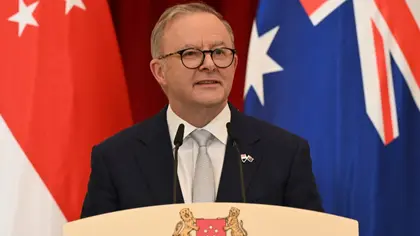Australia has announced its first support for Ukraine in eight months, and a key feature is 30-year-old armored personnel carriers (APCs) which Australian soldiers call “buckets” and are not used in combat because of their “vulnerability to attack.”
Prime Minister Anthony Albanese announced a $74 million military and humanitarian aid package in Canberra today. It consists of:
JOIN US ON TELEGRAM
Follow our coverage of the war on the @Kyivpost_official.
· 70 military vehicles, including 28 M113 APCs, 14 ‘Special Operations Vehicles,’ and 28 Rheinmetall MAN 40M medium trucks and 14 trailers;
· Supply of 105mm artillery shells; and,
· $10 million in humanitarian aid for shelter, health services, clean water and sanitation needs.
“This latest package of support demonstrates that Ukraine can count on Australia,” the Australian PM said.
“We support international efforts to ensure Putin’s aggression fails and that Ukraine’s sovereignty and territorial integrity prevails. Australia is unwavering in our resolve to condemn and oppose Russia's actions and to help Ukraine achieve victory,” Albanese said.
Ukraine’s Ambassador to Australia, Vasyl Myroshnychenko, welcomed the new package, but also noted the need for further help as per Ukraine’s past requests.
On behalf of the Government of Ukraine, I thank the Commonwealth of Australia and the Australian people for their most recent package of military and humanitarian support for Ukraine.
— Vasyl Myroshnychenko (@AmbVasyl) June 26, 2023
I am reassured by the Prime Minister’s strong statement that Australia is unwavering in its…
“I am optimistic about further working with Australia to bring Russia’s war on Ukrainians, on global security and our shared democratic values to an end,” the Ambassador said.
“This includes further progressing Ukraine’s requests for Australia’s proven and life-saving Bushmasters, available Hawkeis, and tanks,” he said.
A community campaign in Australia strongly advocated for the provision of Hawkei light infantry vehicles to Ukraine. Hundreds of recently manufactured vehicles are parked on a lot in a regional city. The Australian Army apparently does not wish to take possession of them for a technical reason that Ukrainian sources find to have minimal risk.
Australia’s Opposition called the announcement by its political opponent “too little too late.”
“While this assistance is desperately needed and has complete bipartisan support, its impact on the ground would likely have been far greater had it been delivered sooner,” the Opposition’s Defense and Foreign Affairs spokesmen said in a statement.
“The Government must… provide a full and reasonable explanation as to why the requests of the Ukrainian government have not been fulfilled. Today’s announcement does not include the military capabilities Ukraine has been publicly campaigning for,” they said.
A preliminary assessment by Kyiv Post of the pledged Australian vehicles revealed aspects that could be of concern to Ukrainian leaders – and battlefield commanders.
In terms of ‘Special Operations Vehicles’ announced, these are known to actually be LRPVs (Long Range Patrol Vehicles) which were last actively used by Australian special forces in Afghanistan. They have now been fully replaced by Bushmasters – which are prized by Ukrainian units following the deployment of up to 90 in battlefield situations.
In terms of the APCS announced, the original design of Australia’s remaining M113 APCs – about 430 of them – dates to the 1960s, when the US-made vehicles were heavily used by Australian forces in Vietnam.
Following a major upgrade/purchasing program in the 1990s, and then an additional one in the early 2000s, the last upgrade/purchase of any Australian M113AS4 in the Australian Army took place in 2012. Therefore, the newest available vehicle is at least ten years old; a substantial amount of the fleet will be around 30 years old.
M113 production was completely terminated in 2007, and M113s were not used by Australian forces in either Iraq or Afghanistan.
Open sources say that “despite the upgrade program, the Australian Army's M113s are now obsolete, and they have not been included in recent deployments due to their vulnerability to attack.”
The Australian Army has said that the remaining M113s are “not expected to be deployable for anything other than low intensity/low-risk missions beyond 2025.”
A project to completely replace and retire the M113s with alternative infantry fighting vehicles is underway, and the current 430 M113s will be replaced with 130 new infantry fighting vehicles, according to the Government’s recently conducted Defense Strategy Review.
Australia has given Ukraine 28 M113s to date; half under the former Coalition Government and half under the current Labor Government. Ukraine is estimated to have been pledged approximately 300 M113s from various donors.
Since the beginning of Russia’s full-scale invasion, and across two different national governments, Australia has provided around $530 million in military and humanitarian aid to Ukraine. According to the Kiel Institute’s Ukraine Support Tracker, that places it around 19th in the world in net terms and around 30th in the world in percentage of GDP terms.
A Bloomberg analysis released last week found that “in the 15 months [as of May 2023] since Moscow launched its invasion, the spike in energy and other commodity prices has given Australia around an A$150 billion [Australian dollars; $102 billion US -ed.] export bonanza.”
The Center on Clean Energy and Air, an independent thinktank, last week showed that Australia has imported more price-capped Russian oil – via the ‘laundromats’ of China and Singapore – than any other single country in the world, including the US. This despite Canberra’s promise not to import Russian energy products.
You can also highlight the text and press Ctrl + Enter







